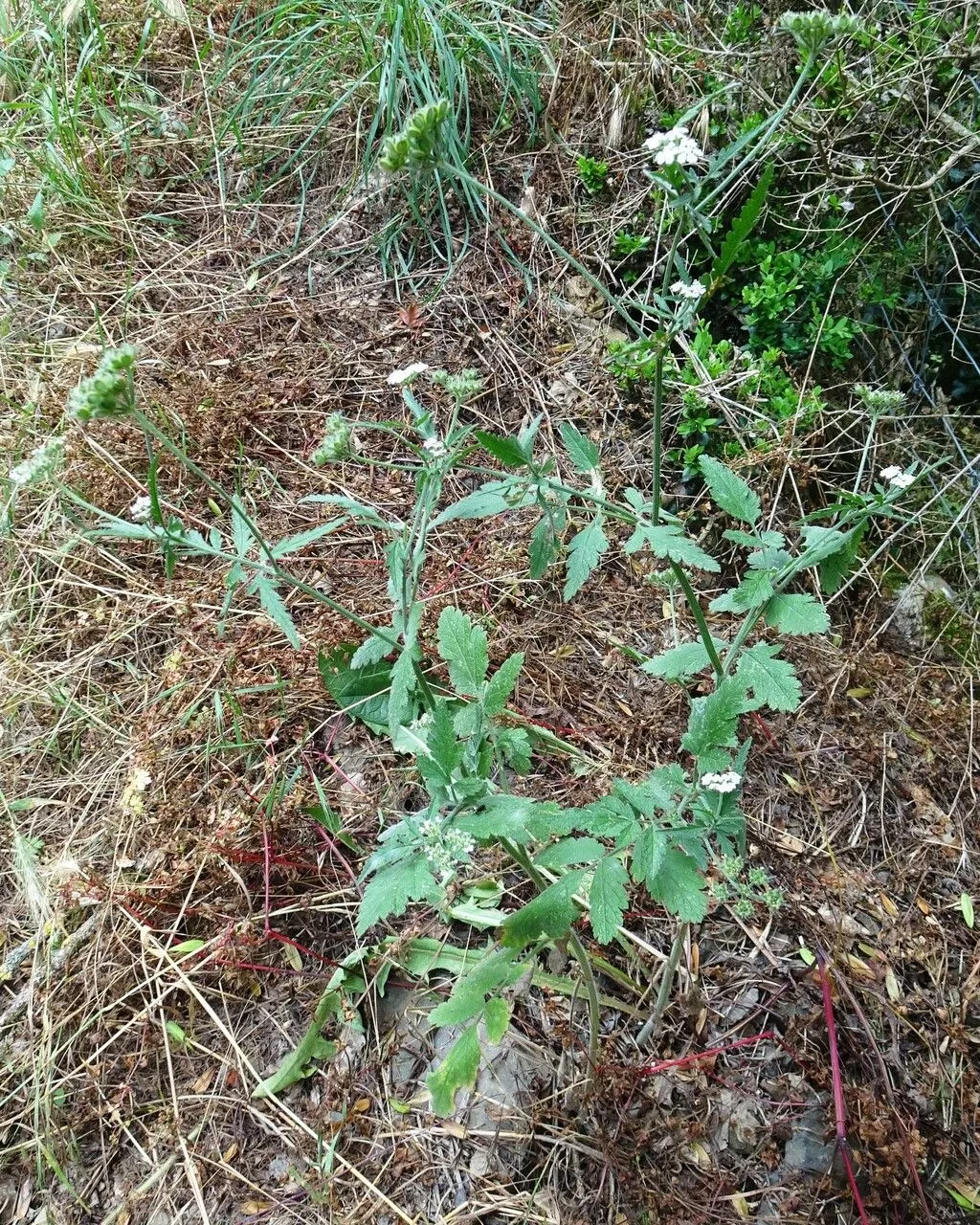
Author: L.
Bibliography: Sp. Pl.: 240 (1753)
Year: 1753
Status: accepted
Rank: species
Genus: Tordylium
Vegetable: False
Observations: EC. & S. Europe to N. Iran
Hartwort, scientifically known as Tordylium maximum, is a captivating species falling under the Apiaceae family. This plant has demonstrated a remarkable adaptability across diverse geographic landscapes, flourishing from the expanse of Eastern and Southern Europe to the reaches of Northern Iran.
The earliest recorded formal classification of Hartwort can be traced back to 1753, as documented in the seminal work “Species Plantarum” by the renowned botanist Carl Linnaeus. This publication, which remains a cornerstone in the field of botany, meticulously outlined the structural and ecological characteristics of Tordylium maximum, embodying Linnaeus’ invaluable contributions to botanical nomenclature.
Characteristically, Hartwort embodies the typical features of the Apiaceae family, boasting finely divided leaves and an inflorescence that forms an umbrella-like cluster, often referred to as an umbel. This structure not only facilitates the plant’s reproductive success by attracting a variety of pollinators but also adds to the aesthetic appeal of natural and cultivated landscapes where it is found.
The ecological range of Tordylium maximum is particularly notable; its presence spans across a considerable breadth of Europe and extends into the distinct climatic zones of Northern Iran. This ability to thrive in varied environments underscores the plant’s resilient nature and its adaptability to different soil types, altitudes, and climatic conditions.
Thus, Hartwort is not only of ecological and horticultural interest but also holds historical significance within botanical studies. Its extensive distribution and characteristic features make it a frequent subject of study for botanists and plant enthusiasts aiming to deepen their understanding of the Apiaceae family and the evolutionary mechanisms that enable plant species to adapt to diverse environments.
Deu: große zirmet, zirmet
Eng: hartwort
Dan: stor skjoldfrø, stor tordyl, tordyl
Swe: strävsilja
Cym: carllys mawr, carwlys, carwlys mawr, hyddlys
En: Hartwort
Ar: طرديلن أكبر
Bg: Обикновена нузла
Cs: Zapalička největší
Da: Stor skjoldfrø, Stor tordyl, Tordyl
Nl: Tordylium
Fi: Kaulusputki
Fr: Grand Tordyle, Tordyle élevé, Tordyle majeur
De: Große Zirmet, Zirmet
It: Ombrellini maggiori
Sv: Strävsilja
Cy: Hyddlys, Carllys Mawr, Carwlys, Carwlys Mawr
© copyright of the Board of Trustees of the Royal Botanic Gardens, Kew.
© copyright of the Board of Trustees of the Royal Botanic Gardens, Kew.
© copyright of the Board of Trustees of the Royal Botanic Gardens, Kew.
Taken Jun 11, 2014 by Tela Botanica − Mathieu Sinet (cc-by-sa)
Taken Jun 3, 2021 by Jacques Maréchal (cc-by-sa)
Taken Jun 28, 2021 by Alain Bigou (cc-by-sa)
Taken May 27, 2021 by Ludi Granja González (cc-by-sa)
Taken Jun 15, 2020 by isabel pueyo (cc-by-sa)
Taken Oct 3, 2021 by Trap Hers (cc-by-sa)
Taken Oct 3, 2021 by Trap Hers (cc-by-sa)
Taken Jan 29, 2021 by Lezaun Juan Antonio (cc-by-sa)
Taken Jun 28, 2021 by Alain Bigou (cc-by-sa)
Taken Jun 11, 2021 by Mamen Sasevi (cc-by-sa)
Taken Jun 20, 2012 by Tela Botanica − Emmanuel STRATMAINS (cc-by-sa)
Taken Jan 1, 1970 by Photoflora – L’Abbé COSTE (©)
Taken May 21, 2012 by Tela Botanica − Dominique DUVEAU (cc-by-sa)
Taken Jun 11, 2014 by Tela Botanica − Mathieu Sinet (cc-by-sa)
Taken Oct 3, 2021 by Trap Hers (cc-by-sa)
Taken Jun 14, 2014 by Tela Botanica − Paul FABRE (cc-by-sa)
Taken Jun 14, 2011 by Tela Botanica − Bertrand BUI (cc-by-sa)
Taken Jun 28, 2021 by Alain Bigou (cc-by-sa)
Taken Jun 11, 2021 by Mamen Sasevi (cc-by-sa)
Taken Jun 11, 2021 by Mamen Sasevi (cc-by-sa)
Taken Jun 14, 2014 by Tela Botanica − John DE VOS (cc-by-sa)
Taken Jun 10, 2015 by Tela Botanica − George FOWLER (cc-by-sa)
Taken Jun 21, 2015 by Tela Botanica − Jean-Jacques HOUDRÉ (cc-by-sa)
Taken May 31, 2014 by Tela Botanica − Sylvain PIRY (cc-by-sa)
Taken Jun 20, 2016 by Tela Botanica − Genevieve BOTTI (cc-by-sa)
Taken Jun 9, 2012 by Tela Botanica − Jean-Luc GORREMANS (cc-by-sa)
Taken Jun 2, 2019 by Tela Botanica − Sylvain Piry (cc-by-sa)
Taken Jun 4, 2012 by Tela Botanica − Bertrand BUI (cc-by-sa)
Taken Jun 9, 2018 by Tela Botanica − Henri SCORDIA (cc-by-sa)
Taken Jun 28, 2021 by Alain Bigou (cc-by-sa)
Ph maximum: 7.0
Ph minimum: 6.5
Light: 7
Atmospheric humidity: 5
Bloom months: [‘jun’, ‘jul’, ‘aug’]
Soil nutriments: 6
Family: Myrtaceae Author: (F.Muell.) K.D.Hill & L.A.S.Johnson Bibliography: Telopea 6: 402 (1995) Year: 1995 Status:…
Family: Rubiaceae Author: Pierre ex A.Froehner Bibliography: Notizbl. Bot. Gart. Berlin-Dahlem 1: 237 (1897) Year:…
Family: Sapindaceae Author: Koidz. Bibliography: J. Coll. Sci. Imp. Univ. Tokyo 32(1): 38 (1911) Year:…
Family: Asteraceae Author: A.Gray Bibliography: Pacif. Railr. Rep.: 107 (1857) Year: 1857 Status: accepted Rank:…
Family: Fabaceae Author: Medik. Bibliography: Vorles. Churpfälz. Phys.-Ökon. Ges. 2: 398 (1787) Year: 1787 Status:…
Family: Aspleniaceae Author: (Cav.) Alston Bibliography: Bull. Misc. Inform. Kew 1932: 309 (1932) Year: 1932…